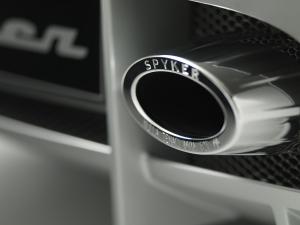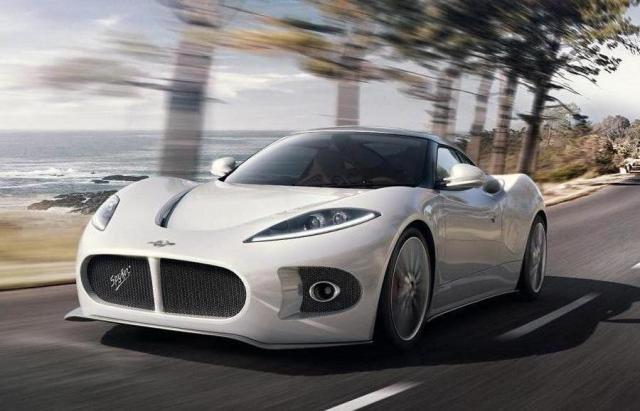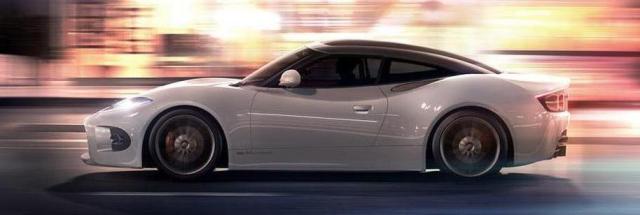On the fringes of the “top tier” of super sports car makers (think Ferrari, Lamborghini, Porsche and McLaren) that make their own engines for their much-admired creations lies another group of manufacturers that depend on larger outside carmakers for the powertrains that drive their exclusive boutique sports cars. The 1960s and 1970s saw a wealth of primarily Italian and British sports and GT cars (Iso, De Tomaso, Monteverdi, Intermeccanica and Jensen, among others, come to mind) that relied on Detroit 3 V8 power. Lotus’ sports car engines have, primarily, been tuned derivatives of Ford, Renault, General Motors and, most recently, Toyota engines. Supercars from Koenigsegg and Pagani are powered by variants of Ford and Mercedes/AMG engines. Even Aston Martin’s V12 started out as two Ford Duratec V6s mated together. And, tentatively returning from a near-death experience is Dutch-turned-British Spyker, whose multiple concepts and hyper-limited production cars (a 300+ production run over a dozen years makes even the Lexus LFA seem mass-produced by comparison) have been Audi-powered.
 Reeling from their “guppy trying to swallow a whale” attempt to buy the bankrupt Saab cars and currently down to a single C8 Aileron model, Spyker’s comeback is centered around the B6 Venator model shown throughout this story that just debuted at the 2013 Geneva Motor Show. Most of the world’s automotive press simply and dutifully parroted the official Spyker news release in noting that it is propelled (pun half-intended) by a transversely-mounted, rear-mid-engined V6 delivering 375+ horsepower through a 6-speed automatic transmission of undisclosed parentage. As Motor Trend‘s Christian Seabaugh noted,
Reeling from their “guppy trying to swallow a whale” attempt to buy the bankrupt Saab cars and currently down to a single C8 Aileron model, Spyker’s comeback is centered around the B6 Venator model shown throughout this story that just debuted at the 2013 Geneva Motor Show. Most of the world’s automotive press simply and dutifully parroted the official Spyker news release in noting that it is propelled (pun half-intended) by a transversely-mounted, rear-mid-engined V6 delivering 375+ horsepower through a 6-speed automatic transmission of undisclosed parentage. As Motor Trend‘s Christian Seabaugh noted,
Given Spyker’s history of using Audi-sourced powertrains, we suspect the Venator is powered by Audi’s 3.0-liter supercharged V-6, which makes 333 hp and 325 lb-ft of torque in the S5.
Leave it to Pulitzer Prize-winning journalist Dan Neil, however, to not only break the story in the Wall Street Journal of Spyker’s new less-expensive model, but to notice that
The Venator also bears a striking resemblance, in profile and in specification, to the Toyota-powered Lotus Evora S, though Mr. Muller declined to specify his powertrain supplier.
 Indeed, a cursory glance at the Spyker B6 Venator reveals a number of Lotus Evora cues such as similar overall proportions, shallow doors, deep side sills, engine air intakes mounted high right behind the doors’ trailing edge, round taillights (albeit doubled up on the Spyker) and a padded rear shelf-cum-vestigial +2 rear seating. And a transversely-mounted rear mid-engine? Other than the Evora, the last time anybody attempted that in this segment was during the 1970s heyday of the Italian Ferrari Dino GT4 / Lamborghini Urraco / Maserati Merak triumvirate.
Indeed, a cursory glance at the Spyker B6 Venator reveals a number of Lotus Evora cues such as similar overall proportions, shallow doors, deep side sills, engine air intakes mounted high right behind the doors’ trailing edge, round taillights (albeit doubled up on the Spyker) and a padded rear shelf-cum-vestigial +2 rear seating. And a transversely-mounted rear mid-engine? Other than the Evora, the last time anybody attempted that in this segment was during the 1970s heyday of the Italian Ferrari Dino GT4 / Lamborghini Urraco / Maserati Merak triumvirate.
Comparing the meager numbers provided in the official Spyker Venator news release with the Lotus Evora specifications reveals close, but not spot-on wheelbase (98.4″/2500mm for the Spyker vs 101.4″/2575mm for the Lotus), overall length (171.1″/4347mm for the Spyker vs 171.2″/4350 mm for the “base” Lotus Evora and 171.7″ for the Evora S) and weight (under 3086 lbs/1400 kg for the fully carbon fiber-bodied Spyker vs 3179 lbs for a composite-bodied IPS automatic Lotus Evora S) numbers, with both carmakers using an all-aluminum platform. Autocar adds overall width numbers of 74.1″/1882mm for the Spyker vs 72.7″/1846mm for the Lotus.
 We use the above IPS automatic Lotus Evora S comparison advisedly, for the Spyker will seemingly be offered only with a 6-speed automatic, just like the Lotus’ optionally available IPS (Intelligent Precision Shift) transmission that is essentially the U660E 6-speed automatic transaxle used in front-wheel-drive V6 versions of the latest Toyota Avalon, Camry (including the Australian-built Aurion), Sienna and Venza, as well as Lexus’ ES 350 and RX 350. We remind you, though, that Lotus adds paddle shifters as well as sport and a full-manual mode that includes a lockup torque converter for 2nd-thru-top gear à la IS F. And the Spyker B6 Venator engine’s claimed 375+ hp is far closer to the Evora S engine (a Lotus-tweaked, 345 hp version of Toyota’s rare supercharged 2GR-FZE 3.5-liter V6 that debuted in Australia’s short-lived Aurion TRD) than to the base Evora’s naturally aspirated, 276 hp 2GR-FE 3.5-liter V6.
We use the above IPS automatic Lotus Evora S comparison advisedly, for the Spyker will seemingly be offered only with a 6-speed automatic, just like the Lotus’ optionally available IPS (Intelligent Precision Shift) transmission that is essentially the U660E 6-speed automatic transaxle used in front-wheel-drive V6 versions of the latest Toyota Avalon, Camry (including the Australian-built Aurion), Sienna and Venza, as well as Lexus’ ES 350 and RX 350. We remind you, though, that Lotus adds paddle shifters as well as sport and a full-manual mode that includes a lockup torque converter for 2nd-thru-top gear à la IS F. And the Spyker B6 Venator engine’s claimed 375+ hp is far closer to the Evora S engine (a Lotus-tweaked, 345 hp version of Toyota’s rare supercharged 2GR-FZE 3.5-liter V6 that debuted in Australia’s short-lived Aurion TRD) than to the base Evora’s naturally aspirated, 276 hp 2GR-FE 3.5-liter V6.
It should also be noted that the currently struggling Lotus Cars certainly hasn’t been averse to sharing its sports cars’ basic structure with other carmakers. The Elise/Exige fraternal twins form the foundation for vehicles as diverse as the battery electric Tesla Roadster and the “hypercar” Hennessey Venom GT, and a one-off 414E Hybrid concept version of the Evora evolved into the Infiniti Emerg-E concept that appeared at last year’s Geneva show. Thus, it certainly wouldn’t be unusual for Lotus to sell the Evora’s underpinnings to Spyker as the basis for their new B6 Venator model. But is the Evora S Toyota-sourced powertrain also included in the deal? Spyker staffers, from CEO Victor Muller on down, are keeping mum on this point. We should note, however, that a number of internet reports are stating a 3.5-liter capacity for that V6, even though the official Spyker news release doesn’t mention engine size. Add that to the web of circumstantial evidence pointing towards a Lotus Evora/Toyota connection for the B6 Venator.
 Yet, we can’t disregard a clumsily-translated article from the 500autos.com site that suggests the Spyker B6 Venator’s roots lying not in the Lotus Evora but, instead, as a derivative of the stillborn, Henrik Fisker-penned Artega GT that was powered by a Volkswagen/Audi-sourced 3.6-liter V6, in keeping with Spyker’s affinity for Audi powerplants. Then again, Road & Track magazine’s Alex Kierstein asked Spyker chief commercial officer John Walton about the company’s larger, Audi V8-powered C8 Aileron model and got this surprising reply:
Yet, we can’t disregard a clumsily-translated article from the 500autos.com site that suggests the Spyker B6 Venator’s roots lying not in the Lotus Evora but, instead, as a derivative of the stillborn, Henrik Fisker-penned Artega GT that was powered by a Volkswagen/Audi-sourced 3.6-liter V6, in keeping with Spyker’s affinity for Audi powerplants. Then again, Road & Track magazine’s Alex Kierstein asked Spyker chief commercial officer John Walton about the company’s larger, Audi V8-powered C8 Aileron model and got this surprising reply:
“[The Audi-sourced V8] really hasn’t got enough bang for the buck. To be honest, every supercar needs to have something that begins with a ‘5’ today. That’s why we’re supercharging the car in the future, which will take it to over 500-hp.
“Our opportunity to develop that particular engine was really over. And I wanted to look at other opportunities, that weren’t necessarily always V8s.”
Does this mean it may be a forced induction V6, one of the options being considered for the yet-to-be-sourced powertrain for the Venator?…
“We’re not in any hurry to jump to the next generation. Having said that, the development work we’re doing with engine suppliers on the Venator allows us to actually look at slotting something into [the Aileron] too.”
Kierstein goes on to say that an engine supplier is not yet lined up, but it is notable that Spyker seemingly isn’t as wedded to Audi power, even in the larger C8 Aileron, as we once thought, a notion seconded by Car and Driver‘s Jens Meiners. Hopefully, Kierstein’s upcoming interview with Spyker CEO Victor Muller will shed some light on the subject, while Jalopnik‘s Máté Petrány suggests that “we will know more in a month’s time”. In the meantime, we will say that, quirky as the B6 Venator is from some angles, it’s definitely more compelling than another super-limited production, Toyota V6-powered rear-mid-engined luxury GT 2-seater, the Mitsuoka Orochi…




Be First to Comment